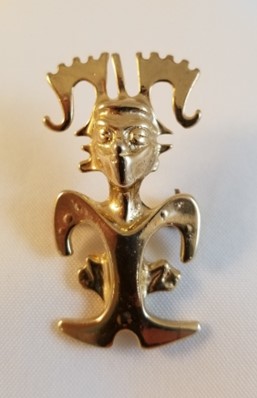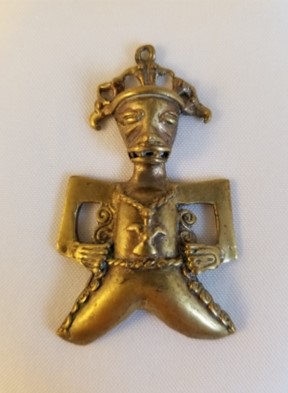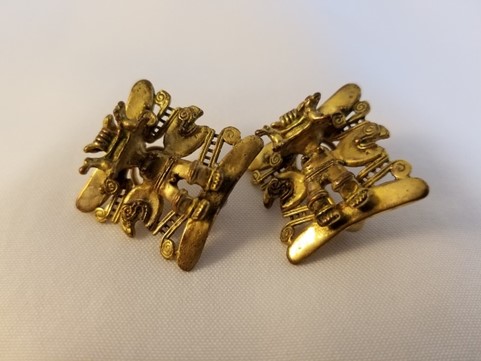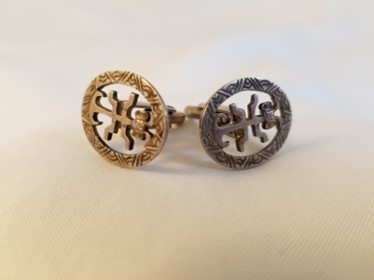The objects in this exhibit are reproductions of metalwork art produced by Pre-Columbian cultures of the Isthmian Region. Although the burials of the Isthmian Region have been heavily looted, recent excavations of intact sites confirm that these objects were used as personal adornment during life and as burial offerings after death; they also suggest that all aspects of Isthmian metal art– the material, shape, motifs, design, and context – appear to symbolize status and power. Accordingly, the people who wore these pieces were likely individuals of high status, including shamans or priests/priestesses and royalty.
Ancient Isthmian metal art were typically made of gold, silver, or tumbaga, an alloy of gold and copper or of silver and copper. The artists of this region were highly skilled in lost-wax casting, in forging, and in finishing these metals, as well as in creating alloys that facilitated these techniques. This metalwork was also highly polished, and it is dazzlingly reflective in the bright sunshine of this region; scholars have speculated that wearers of these pieces were therefore likely perceived as being supernaturally powerful. Scholars have also suggested that the metals used in these objects were symbolic, and that certain alloys were perceived to represent the sun and the moon, with the sun representing masculinity and immortality, and with the moon representing femininity and regeneration.
Common motifs represented in Isthmian Region art include stylized humans and human-animal combinations as well locally known predatory animals such as crocodiles, bats, eagles, panthers, and marine life. These images likely represented powerful characters in Isthmian cultural stories and mythology.

Original: Gran Coclé cultural zone
Original: 6th-16th century
Base metal and paint, L. 2.4 cm x W. 4.7 cm x H. 9 mm
BFPC collection #2013.26
The Figure with Covered Mouth is the reproduction of a Gran Coclé cultural zone gold pendant or pectoral. The original pectoral is one of the few Isthmian Region objects that was recovered in an excavation, and its discovery at the site of Sitio Conte confirms that was made by the Gran Coclé cultures. The original piece is made from cast gold using the lost-wax technique, which was forged to flatten certain areas and then polished. The figure most likely represents a cacique, a term that originally meant “governor,” but that here indicates an Isthmian high-status individual. Researched by Alex Ennor

Original: Greater Chiriquí cultural zone
Original: 6th-16th century
Base metal and paint, L. 3.3 cm x W. 5.2 cm x H. 2.5 cm
BFPC collection #2012.45
The Figure Wearing an Eagle Pendant is the reproduction of a cacique pendant made in the style of the Greater Chiriquí culture. Interestingly, the figure is wearing a headdress depicting birds and a Greater Chiriquí-style eagle pendant on its chest, in a similar fashion to how this pendant itself would be worn. The original piece’s thin, fine details, such as the headdress figures and the spiral pattern on the sides of the figure’s legs and torso, illustrate the skill of the artist who made this figure using the lost wax technique. Researched by Alex Ennor

Original: Greater Chiriquí cultural zone
Original: 5th-7th century
Base metal and paint, L. 3.5 cm x W. 6.5 cm x H. 6 mm
BFPC collection #2011.7
This unusual piece is the reproduction of a zoomorphic pendant from the Greater Chiriquí cultural zone. The figure has a beak shape that is characteristic of this region, as well as forged bird-like wings at the sides. It also has ridges in the middle, like that of a crustacean. Researched by Alex Ennor

Original: Diquís culture
Original: 13th-16th century
Base metal and paint, L. 2.4 cm x W. 2.5 cm x H. 13 mm
BFPC collection #2013.27
These earrings are reproductions of a Diquís culture crocodile character pendant or pectoral. While the figure has a human body, legs, and feet, the large, protruding snout confirms that this portrays a crocodile supernatural–but this character has also been given large, crab-like claws for arms. Small profile crocodile heads are also visible on each side of the figure, and the overall rectangular shape of the pectoral is also characteristic of works by the Diquís culture. Researched by Alex Ennor

Original: Tolima culture
Original: 5th-10th century
Base metal, L. 2.1 cm x W. 2.7 cm x H. 11 mm
BFPC collection #2018.33
These cufflinks illustrate reproductions of a well-known Tolima culture character that takes the form of a pendant or pectoral. Inside each decorative oval frame is an anthropomorphic character with a cast rectangular head that has whiskers and upright ears. The rest of the character’s body has been forged flat, and the figure’s long tail has been split in two at the end to form a crescent shape. Researched by Alex Ennor
For more information, you may contact the researcher(s) noted in the title of this exhibit entry, or Dr. Billie Follensbee, the professor of the course, at BillieFollensbee@MissouriState.edu
